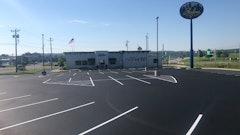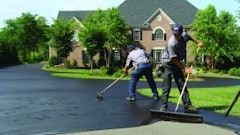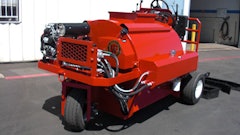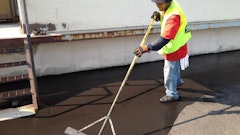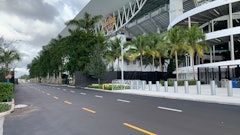
Not all sealcoating contractors are willing to tackle a 2.4-million-sq.-ft. job, especially a complex job that requires 7,000 sq. ft. of repairs and milling and pouring of two concrete pads. But Bayside Sealcoating & Striping, a small contractor working out of Camden, DE, had been laying the groundwork for a job like this, so when the opportunity arose, Dan Wallace and his father, Chuck, decided to give it a go.
"After a day or so on the job my Dad and I just looked at each other and said 'What did we get ourselves into?'" says Dan, vice president and manager. "Things weren't going as we'd planned and we were a little worried."
But the worry didn't last long. With years of successful sealcoating operations behind them, most of them less than 100,000 sq. ft. but also an important 600,000-sq.-ft. job, Bayside had learned lessons is was able to apply as it stepped up to the Big Job.
While Bayside Sealcoating is in its 25th year, it's only been owned by the Wallaces since 2000 when Chuck Wallace acquired it from the original owners. What Chuck bought when he bought the business was Bayside's only truck, the company name, and a customer list. They replaced the truck with a new vehicle almost immediately. "We wanted to put a second truck on the road, but we weren't able to because we had trouble getting enough good help to run a second crew," Dan says.
Since then they have transformed it from a weekend-only business. Once Dan got out of school five years ago Bayside began pursuing commercial contracts in an effort to move the company away from its driveway sealcoating roots, and the company has grown 20% to 30% every year by adding new customers while retaining original customers. "The last two years especially we have really pushed to get commercial work. We've even eased back on prices a little," Dan says.
But more than tightening their margins, Wallace says they try to make their mark with commercial customers by making a personal impression on every job, by making every effort to work with them, and by making sure to take care of them. "If they need prices broken out 25 different ways we'll do it; whatever they need," Dan says. "We tell our guys 'If there's any question that something needs to be done, if you question it, don't even question it, just do it.' We try to do something that sets us above everybody else."
And Bayside works to provide that little extra to its existing customers as well. "If you're my customer and you try someone else, and then you come back to me, you're a new customer and you're treated and priced like a new customer," Dan says. "If you're our customer, you're our customer. And if you're not, then you're not and you're a new customer. If you're a three-year customer you get a better price than a new customer. If you go and come back you're a new customer."
Currently Bayside generates 60% of sales from residential work and 40% from commercial work - a big change from the 100% weekend residential sealcoating the drove the company when Chuck Wallace acquired it. Wallace says 95% of Bayside's work is sealcoating (including crack repair), and 5% is striping performed on its own sealcoating jobs. Mike Masters, Dan Wallace's brother-in-law, does virtually all layout and striping. "Basically we only stripe behind our own work. We're too busy sealcoating all the time to pursue striping work by itself," Dan says.
Bayside employs five people full time, including Chuck and Dan. But they rely on what Dan terms an "endless list" of people who are available to work nights and weekends to help them handle the bigger jobs or jobs on tight deadlines.
"We compiled the list from construction industry contacts from the building market," Wallace says. "Word got around that if people needed some extra cash the opportunity was there, and we started getting calls and developing a list of people we can call when we need help. Sometimes it doesn't work out with some of the people but sometimes it does. There's a lot of work we couldn't be able to get done without our part-time help."
In addition to sales, Dan also worked in the field, eventually taking over as crew leader from the person who trained him. He says Bayside makes a concerted effort to bid jobs right on site, the first time they visit a prospect. He's able to bid on site successfully 100% of the residential work and most of the commercial work because he carries a laptop computer with a printer in his truck.
"I view the job, measure it out, type it into the laptop, and print it out right there and give it to the customer right then," Dan says. The only time he doesn't hand the bid over immediately is if there's paving work involved, and then he takes the information back to the office and gets one of two paving subcontractors involved in developing the bid.
Eventually Bayside bought its second truck, a Ford F550, to go along with its F350. The 350 is equipped with a 500-gal. sealcoating tank and the 550 carries a 600-gal. tank. Both tanks were built by Chuck, complete with hydraulics, a 2-in. diaphragm pump and compressor. In addition to building the tanks, Chuck Wallace customized the trucks to carry just about everything a sealcoating crew could need: Bayside's custom-built hot pour crack repair melter, space for propane tanks beneath the truck bed, brooms, squeegees, sand (for sealer, for sanding fresh oil spots, and for sanding cracks), walk-behind blowers, hand-held blowers, a weed eater "because we edge every driveway and commercial building we go to," and a barrel with a lid holding 6-in. trim brushes so the brushes don't get hard.
"There's a spot for everything," Dan says. "The trucks are jam-packed."
Chuck Wallace also built a 9-ft. removable spray bar with six tips and a custom-built seat on the back of the truck that enables the operator to keep an eye on the tips to make sure they don't clog up.
A first step up
Located just more than an hour south of Camden in Millsboro, DE, Dan Wallace got a call to bid on a 600,000-sq.-ft. job, and he visited the property and bid the job the same day. After confirming the blueprints, which he says were "right on," he called his Neyra Industries sealer supplier for a quote on 3,500 gallons of bulk sealer, then did the same with his sand and additive suppliers.
"Getting those bulk rates probably helped us get the job," he says.
Once Bayside was awarded that bid, Wallace went back to the site to select a staging area. "It was a big job, and we wanted to be able to store everything right there for easy access," Wallace says. Cracksealing was done under the parking lot lights so the pavement would be ready to seal the next morning. Chuck drove one truck back and forth 15 miles to the supplier to pick up material, and Dan and the crew sealcoated the pavement. They cleaned an area with blowers, then sealed the area by driving around the perimeter and filling in the center of the pavement last-and they learned some lessons from that that would be handy on the big job. One person filled 55-gal. barrels with water for the mix design while the others were sealing, and Bayside learned from that, too.
"We weren't exactly sure what to expect," Dan says. "When they called and said we had the job I asked 'why?' and I got the answer I didn't want to hear: "Because you're the cheapest." I began to worry if we would make enough money - or any money - but we had gone over this closely, and we'd planned it out for each day so we knew where we would be at out there."
And where they would be was ahead of schedule; they'd planned for the work to last six days but they ended up completing the job in four.
Taking on the big job
That, Wallace says, gave them the confidence to pursue even bigger projects, though the 2.4-million-sq.-ft. Wal-Mart Distribution Center did cause them to step back and take a deep breath before submitting the bid. Trucks and trailers moved throughout the property all day except from three to six in the morning.
"We actually dragged our feet getting them a price," Dan says. "I said 'Give us a month' as I was kind of overwhelmed bidding that big a job and that complex a job, but I finally just decided either I'm going to bid it and try to get it or I've got to tell them to get somebody else."
So Wallace spent almost four full days breaking down the job, calling suppliers, examining measurements, setting up schedules, basically utilizing everything he learned on the 600,000-sq.-ft. job, and putting the bid numbers together. Not only was the job huge, it required 6,000 sq. ft. of patching plus milling of two 1,800-sq.-ft. areas so concrete pads could be poured. Patching, milling, and concrete work was subbed out and completed before Bayside was on the job to seal and stripe.
"The first big problem I ran into was help. Where were we going to get the help because we couldn't do that big a job all on our own," he says. But he had his list, and he started making calls. Eventually he had the job priced and planned out (he figured 28 to 30 days depending on weather). He submitted the bid and then waited.
"We didn't hear back from them for two months, but then they called and said they were ready to go. I said 'give me two weeks,' and I started lining up workers. We ended up keeping 12 people out there most days," Dan says.
Once they had been awarded the contract and lined up their help, the Wallaces paid a visit to the site. They decided the job required a staging area. The location had to have access to water, access for regular sealer delivery without disrupting Wal-Mart operations, enough space for a drop tank, space for some type of storage shed, plus their vehicles.
"We had to choose a place that was out of the way for them but still centrally located for us and for all the work," Dan says. "We needed easy drive-up access from both sides of the parking lot and either way around the building."
They placed the staging area on the back side, with the access they needed, and fenced it in with chain link. "We put up a security fence around the staging area not only to protect us from cars but there were so many people around that we wanted to protect our equipment," he says.
Once Wallace calculated how much sealer the job would require, he contacted Neyra Industries, which dropped a 6,000-gal. bulk tank to the site and set it in the staging area.
Planning for the big job
The division of labor was designed to keep everything moving and to train people on only one task. The 12-person crew would be divided by job. Some people would blow the parking lot all day long using 8-hp Little Wonder blowers; some would trim along edges; Chuck would drive the sealcoating tank, another worker would sit in the chair on the back to monitor application and the spray tips, another would manage the staging area, Masters would paint once it was dry, and Dan Wallace would supervise, coordinate, and communicate with Wal-Mart.
Sounds like a plan
But Bayside discovered the first problem on the first day, as soon as they showed up to start work.
"We didn't coordinate enough with the help to let them know when we'd start working," Dan says. "We showed up that first day at the site and we were looking at six of us all together, including my dad and me."
On day two they had more help but still not what they'd planned on, plus everyone was new and just learning what to do. Wallace says the first few days they ran the job just like they did the 600,000-sq.-ft. job, with each blower cleaning its own area and applying sealer from the perimeter toward the center.
"But as we were working it just didn't make any sense. Because of the configuration and size of the parking lot it just wasn't efficient," Dan says.
So they made some changes. First, they lined up the walk-behind blowers and walked them across the parking lot at the same time, which Dan says was much faster. To help prepare the pavement Bayside Sealcoating rented an 8-ft. broom sweeper for the month. Chuck Wallace drove the sweeper, which ran ahead of the blowers to pick up sand and the bigger debris. "We figured use of that sweeper easily cut our blowing time in half," Dan says.
Bayside also set up a crew that did nothing but edge and do all handwork. They even dedicated a 300-gal. tank of sealer to the edging crew so they wouldn't have to waste time waiting for sealer to be delivered to them.
"They let the sealer out into 5-gal. buckets, put the sealer down along the edge, then moved the bucket along," Dan says. "It was a slow process and there was a lot of edging, but we had a very efficient operation because we devoted a truck with sealer tank to that crew. They never had to wait for sealer. The longest time they had to wait was while their 5-gal. bucket was being filled with sealer from the 300-gal. tank."
They also decided to apply sealer in broad strokes across the length of the pavement instead of around the perimeter. Those changes, plus getting the crew trained, had a huge impact on the job - and on Wallaces' morale.
"The first couple of days we put down four loads a day, and we started to wonder what we'd gotten ourselves into. But a day or so after that we had a day where we sealed 250,000 sq. ft. in one day, and when we did that I knew we'd be fine," Dan says.
Eventually production settled into applying an average of eight 500-gal. loads of sealer a day.
"Then we had a couple of longer really productive days where we did 12 loads," Dan says. "The largest stretch on the property is a half mile and the days we were working on that we were able to put down 12 loads."
"One of the keys to this job was we just kept things moving. We didn't stop once we were out there," Dan says. "On the 600,000-sq.-ft. job we sealcoated around the outside of the parking lot and did the inside later. On this job we did 100% of one area, and we did not leave an area until it was completely done."
Part of keeping things moving was loading the sealer truck as quickly as possible to get it back out working on the lot.
"It took us a day or two to figure out the best way to get that truck loaded and back out as quickly as possible," Chuck says. "The first time we put the hose from the bulk tank into the top of the tank but we had to have someone stand there and hold it so it wouldn't splash out of the tank."
So Bayside installed a quick disconnect on the spray bar and connected the bulk tank hose to that. "We'd pull in, disconnect the hose from the tank to the spray bar, connect the hose to the tanker, and run everything in reverse," he says. "That's how we filled the tank with sealer concentrate."
He says Bayside improved efficiency of loading the sealcoating truck by relying on a 210-gal. plastic tank with a water meter. A hose from the building was connected to the water tank, and water was metered into the tank while the sealcoating truck was sealcoating the lot. By the time the sealcoating truck ran out of sealer, the water tank was filled. The sealer truck returned to the staging area, crews connected a 3-in. pump to the water tank and the sealer truck, and pumped the water into the truck.
Adding water that had already been metered saved the crew a lot of time. "With a little garden hose it would have taken a long time to fill with water so we used a 3-in. trash pump and pumped out of the plastic water tank into the top of the sealer tank," he says.
Bayside metered 125 gallons from the building to the tank, while the truck was out sealcoating, then pumped 125 gallons out of the water tank into the sealer tanker.
"It was not only quicker because we pumped the water faster but it helped us keep the mix consistent because we made sure we had exactly 125 gallons of water in every tank load," he says.
"Between five and eight minutes we were all ready to go with the sealer, water, sand, and additives," Chuck says. "We were pumping sealer and water into the tank at the same time."
While sealer was delivered to the site regularly on a schedule, sand was handled on a will-call basis. "We told them we'd need 16 pallets total, and they just said to let them know a day in advance how much we'd need the following day and they would deliver it," Dan says. "That worked out great."
Bayside's crews worked 28 days straight, seven days a week, to get the job done. "If it wasn't raining, we were working," Dan says. "We flip-flopped days and nights for some high-traffic areas that had to be done when people weren't there."
Solving other problems
One difficulty Bayside ran into was with their paint. Dan Wallace had calculated the lines and amount of paint that would be needed, including how much they could put down in a day to make their schedule. But initially they kept coming up short, and it took a while to figure out what happened.
"We finally figured out that all our paint was shorted, every bucket was a gallon or so short, so our striping wasn't running the way we had planned it and the way it typically did," Dan says. Bayside got the paint manufacturer involved, along with the state's division of weights and measures, which picked up three buckets to test, and they determined all three buckets were short and all were short the same amount.
"So overall we were eight buckets, 40 gallons, short of what we ordered, and that had caused us to scratch our heads on the site at first," Dan says. But the manufacturer made up the difference so the problem was solved before it could become a major roadblock to completion.
But Dan says that just as with other jobs, the biggest problem Bayside had was keeping the work zone blocked off and keeping people out of it. "It was a live site and drivers kept driving between the cones," he says. "We had more cones on this one job than we thought we'd ever own, and we kept moving them closer together and people were still driving between them. So we got to the point where if a car can fit through them they aren't close enough."
Customer coordination
"We had a plan and they had a plan and we kind of had to go with their plan because they were open and needing to keep their trucks moving, so we were working around each other," Chuck says. "So whatever section they would clear the trailers from is the section we went to next."
He says they tried to operate so the yard drivers only had to move each trailer twice - once out of an area and then once back in, and they were successful in that for the most part.
"All I basically did was coordinate between us and the customer," Dan says. "I let them know where we were working, what we'd done, where we were moving to next." He said their biggest impediment to keeping the job moving was that Wal-Mart required that one of its yard drivers move all the trailers.
"But if their drivers were busy - and they were always busy because the facility was open the entire time - we couldn't get one," Dan says.
"So I went and I just tried to explain it to them in terms they could understand as a business. I said 'We're not making any money and we're not doing enough work for you, and I'm paying my labor just to wait until you can move the trailers so we can work.' Once they heard it from that viewpoint it was not a problem at all. In fact their yard drivers really did a great job of moving trailers so we could keep our production rates up."
Wallace attributes part of their success to planning and coordination with their suppliers. "You've got to coordinate with your customer and with all your suppliers," he says.
"We were in touch with our sealer supplier regularly, and they brought us what we needed each day, in fact several times a day on most days. But the biggest thing is planning it all out and getting everything lined up and having the material on the job so we didn't run out and have to stop."





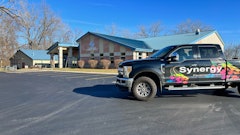
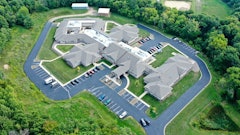





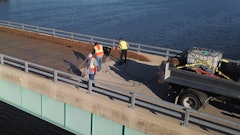




![Screen Shot 2023 01 04 At 5 23 30 Pm[35]](https://img.forconstructionpros.com/files/base/acbm/fcp/image/2023/01/Screen_Shot_2023_01_04_at_5.23.30_PM_35_.63bc42696de27.png?auto=format%2Ccompress&fit=crop&h=135&q=70&w=240)
